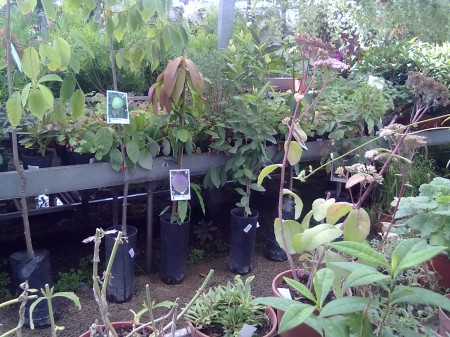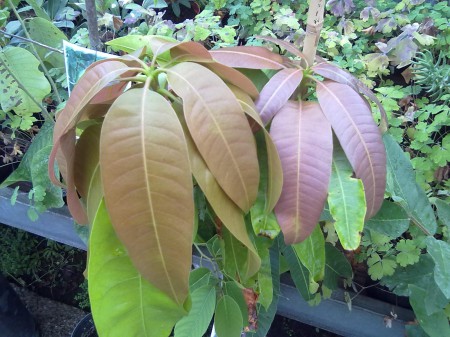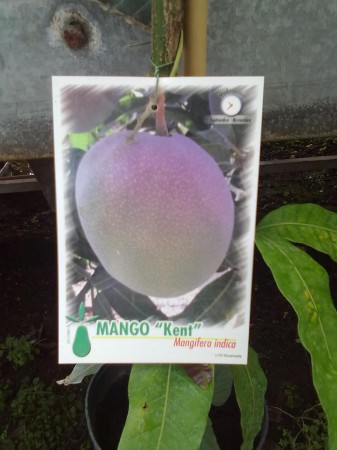- G20 nations turn to agricultural research for food security. All you need to know.
- Would it be worth updating Borlaug on organics? A Prinz says “Yes!”
- Rhizowen gets oca to grow seed to seed. Can Cornish “potatoes” be far behind?
- Is it cassava‘s time?
- Molecular taxonomy helps an allergy sufferer.
- Lagging behind in development? Maybe you’re too diverse. Or not diverse enough. Difficult, in either case, to envisage the solutions.
- Agfax podcast on orange sweet potato in Uganda. Comment on the kuroiler goes for this too.
Climate change in Italy?
A routine trip to the local plant nursery — and a very good nursery it is too — was enlivened by some fairly manky-looking small trees. They seemed quite out of place among the bedding plants and tender annuals, so off I went to investigate. And, boy! was I surprised. Macadamia, Haas Avocado, Litchi, Cherimoya, Guayabay (Guava, but not sure whether it is Psidium or one of the others.) and two kinds of Mango, Kent and Osteen. Now, I know it has been hot here, but will any of these fruit reliably in Italy? Osteen is apparently grown commercially in Spain, but what about the others?
Anyway, I only had my mobile phone with me, but here are some pictures.



Objections to “development”
Fishermen and rice farmers in Cambodia’s Ratanakiri province don’t want dams, electricity or even compensation … They just want to preserve their way of life.
What are they, weird or something?
The villagers in question are objecting to proposed dams on tributaries of the Mekong. And it isn’t as if they want better compensation or anything like that. They just don’t want the dams. They want to keep fishing and growing rice. Ah, but you can’t stop progress, can you?
Double haploids or double Dutch?
It isn’t always easy to pick one’s way through the thickets of undergrowth that spring up in the wake of huge scientific breakthroughs. But honestly, I challenge anyone not intimately involved to make sense of this doozie from the University of California, Davis.
First off, the headline: “Plant breeding revolution for cassava, banana”.
Guess. Has it happened? Next year? Next decade? Who knows.
Now, what exactly are they doing? Here’s the background.
Most successful crop varieties are hybrids created by crossing two inbred varieties. While this is relatively easy to do in well-established annual crops like maize or wheat, it is much harder with slower-growing crops like cassava, banana and plantain. As a result, cassava, banana and plantain growers are currently forced to create new varieties by crossing two hybrid parents — a highly unpredictable process.
New crop varieties allow farmers to cope with pests, disease, drought and other problems.
Working with the small laboratory plant Arabidopsis thaliana, Chan’s lab recently discovered a method to create plant seeds that carry the DNA from only one of their parents, allowing breeders to immediately create a hybrid that “breeds true,” dramatically cutting the time required to create new crops with traits such as disease- or drought-resistance.
All clear? No seriously, this is seriously misleading in so many respects that I have to wonder whether any of the scientists involved actually saw it.
Being as how some of names in the press release are familiar to me, I did a bit of looking around, and discovered that this is merely a follow-up to a little piece we had already Nibbled, and groaned at. Going back to the full piece, I owe my friends at CIAT an apology.
The technique being studied at Davis (and IITA and CIAT) results in an adult plant that contains identical genetic information on all the sets of each chromosome. ((This is tricky, and not only because many crops have more than the usual two sets of chromosomes. Bananas and plantains have three. Cassava too is often polyploid. Anyway, double haploids are diploids in which the two members of a chromosome pair are identical. I’m not sure how very different this is from other forms of apomixis. See me afterwards if this isn’t clear.)) And the main point seems to be that it enables the adult plant to produce seeds that are genetically identical to itself, rather than the genetic shuffle produced by sexual recombination of different chromosomes. So the big deal is that banana and cassava farmers will be able to plant itty-bitty seeds instead of offsets or suckers, which could help to avoid diseases carried inside the plant cells, and would reduce the costs of distributing planting material. If, of course, a good triploid banana can be induced to produce seeds. That remains unclear to me.
But how exactly do double haploids improve breeding? This was the mystery, to me, until I found this video from our friends at CIMMYT, and I’m still not entirely clear how this will help breed bananas.
The point I am laboriously making is that this stuff is interesting. The press release from UC Davis is really celebrating the fact that His Billness “was very interested in the science and had good questions for everyone,” but I wonder whether any of them were about how it will actually deliver on its promise. Call me old fashioned, but I think that a publicly-funded project owes the public a better explanation of what is being done with the money, and why. Or, of course, none at all.
Nibbles: Coffee lupins, Supply and demand, ICT, Cacao, Malnutrition
- Remember that lupin coffee? Mike H provides an update.
- Complex and scary: Resources Research picks over the USDA’s supply and demand figures after the heat and drought.
- USD1 million for ICT in East Africa. Hope they’ll be visiting us.
- USDA finds ancient cacao variety at altitude in Peru; chocolatiers delighted.
- “We’ve got a gap between evidence and policy.” Guess the field. No, really, I dare you. Venture a guess as to what he’s talking about here. Yep, could be anything.